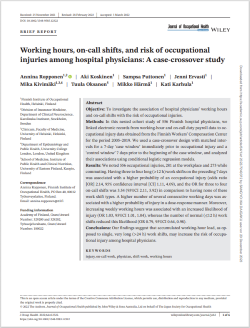#0143 Working hours, on-call shifts, and risk of occupational injuries among hospital physicians: A case-crossover study

Risk of Injury in Physicians Due to Long Working Hours and On-Call Work Shifts
Healthcare workers, especially physicians, work irregular hours in multiple shifts to provide 24-hour patient care in hospitals. While most physicians work on-call hours, many work extra hours in addition to their normal daily working hours. This may result in work stress, burnout, and occupational injuries. As a result, there is an urgent need to identify working-hour characteristics associated with the health and safety of physicians and provide justifications for their working-hour restrictions. While studies on the physicians’ working hours and on-call work shifts have been performed previously, they have relied largely on self-reported data and are, therefore, susceptible to reporting bias.
To address these issues, an international research team investigated the risk of occupational injuries associated with physician workload in Finland. They used electronic records of the working-hour and on-call duty payroll data of 556 physicians from seven Finnish hospital districts between 2005 and 2019 and studied their correlation with occupational injuries. They did so by comparing the working hours during a 7-day “case window” before the injury to that preceding the case window.
The team noted 556 reported occupational injuries, 281 of which occurred at work and included finger/hand(s) injuries, cuts, superficial injuries, dislocations, twists, or strains. The remaining 275 injuries occurred during commuting and ranged from multiple body location traumas to leg injuries.
Long work shifts (>12 hours) for 3-4 consecutive days during the 7-day case window were more likely to cause occupational injuries in physicians. In contrast, the number of normal (≤12 hours) work shifts were linked to fewer injuries. Further, a higher number of consecutive work days also raised the risk of injuries, but did so in a dose-dependent manner. Notably, a cumulative working-hour load was associated with a greater risk of occupational injury than that for single, extremely long (>24 hours) work shifts.
Overall, this study provides novel insights into the nature of working hours that can lead to occupational injuries in physicians. The results may apply to other countries with similar total working hours and should be noted by appropriate authorities to ensure a risk-free work schedule for frontline healthcare workers.

Link to original journal article:
https://academic.oup.com/joh/article/64/1/e12322/7249372
Title of the paper:
Working hours, on-call shifts, and risk of occupational injuries among hospital physicians: A case-crossover study
Authors:
Annina Ropponen, Aki Koskinen, Sampsa Puttonen, Jenni Ervasti, Mika Kivimäki, Tuula Oksanen, Mikko Härmä, Kati Karhula




